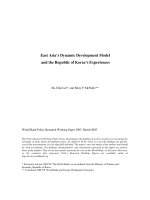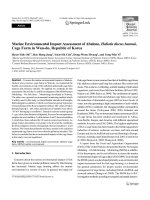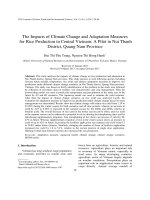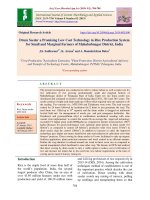2016 rice production update seoul korea republic of 11 29 2016
Bạn đang xem bản rút gọn của tài liệu. Xem và tải ngay bản đầy đủ của tài liệu tại đây (308.73 KB, 5 trang )
THIS REPORT CONTAINS ASSESSMENTS OF COMMODITY AND TRADE ISSUES MADE BY
USDA STAFF AND NOT NECESSARILY STATEMENTS OF OFFICIAL U.S. GOVERNMENT
POLICY
Voluntary
- Public
Date: 11/29/2016
GAIN Report Number: KS1643
Korea - Republic of
Post: Seoul
2016 Rice Production Update
Report Categories:
Grain and Feed
Approved By:
Amanda F. Hinkle
Prepared By:
Sunchul Choi
Report Highlights:
On November 15, 2016, Statistics Korea (KOSTAT) released its revised 2016 rice production estimate
to 4.197 million metric tons (MMT), slightly down from 4.2 MMT, the initial rice production estimate
surveyed for early September 2016. This represents 3.0 percent lower output than last year’s record
crop, reflecting a decline in rice area. Lowered production has also resulted in a 41 percent stocks-touse ratio in MY 2016/17, the highest in several years.
General Information:
Production
On November 15, 2016, Statistics Korea (KOSTAT) released its revised 2016 rice production estimate
of 4,196,691 metric tons, representing a minor decrease from the recent update of PSD (KS1638) due to
continued favorable weather conditions through harvest completion combined with slightly lower
planted area and yield. The PSD has been revised accordingly.
Yield
Favorable weather through harvest completion supported rice yield at 5,389 Kg per hectare. Yields
were higher than average, but down 0.5 percent from a record yield last year.
Crop Year
2005
2006
2007
2008
2009
2010
2011
2012
2013
2014
2015
2016
Korea: Rice Area, Yield and Production
Area (1,00HA)
Yield (KG/HA)
Production (Milled, 1,000 MT)
980
4,900
4,768
955
4,890
4,680
950
4,640
4,408
936
5,180
4,843
924
5,318
4,916
892
4,820
4,295
854
4,946
4,224
849
4,718
4,006
833
5,081
4,230
816
5,200
4,241
799
5,416
4,327
779
5,389
4,197
Source: Ministry for Agriculture, Food, and Rural Affairs (MAFRA)
Korea: 2016 Rice Area, Yield and Production
Type of Rice Land
Area
Yield (KG/HA)
Production (Milled, MT)
Paddy Rice
777,872
5,392
4,194,618
Upland Rice
862
2,405
2,073
Total
778,734
5,389
4,196,691
Source: Ministry for Agriculture, Food, and Rural Affairs (MAFRA)
Crop Year
National Total
Kyonggi
Kangwon
Chungbuk
Chungnam2/
Korea: Rice Area and Production Estimate per Province
(November 15 Crop Survey Basis)
Area (Hectare)
Production (Metric ton)
2015
2016
Change (%)
2015
2016 Change (%)
799,344
778,734
-2.6
4,326,915
4,196,691
-3.0
82,071
80,750
-1.6
420,680
413,916
-1.6
32,300
30,714
-4.9
173,676
166,396
-4.2
39,786
37,114
-6.7
215,115
201,675
-6.2
146,319
137,354
-6.1
827,886
774,105
-6.5
Chonbuk
Chonnam
Kyounbuk
Kyongnam
Cheju
Cities 1/
121,765
170,185
104,712
73,934
128
28,144
121,026
166,444
102,941
70,626
127
31,638
-0.6
-2.2
-1.7
-4.5
-1.0
12.4
700,591
866,202
589,466
389,866
444
142,989
687,398
846,236
576,643
369,032
358
160,931
-1.9
-2.3
-2.2
-5.3
-19.4
12.5
Source: Statistics Korea (KOSTAT)
1/ paddy land located in seven big cities such as Seoul, Pusan etc
2/ Sejong city was included, subtracting the city from Chungnam Province.
Stocks:
MY 2016/17 ending stocks (through the end of October 2017) are forecast to increase to 1.8 million
tons, representing 41 percent of anticipated consumption. Stocks continue to increase as rice production
in the past four years has been greater than demand, which was a result of a continued decline in per
capita consumption.
MY 2015/16 stocks (at the end of October 2016) are estimated at about 1.7 million tons, or 39 percent
of total domestic consumption.
Rice Year (Nov.-Oct.)
Total
Government Stock
-Domestic Rice
-Imported Rice
Civil Stock
Korea: Status of Rice Stocks
(Milled rice, 1,000 MT, as of end October)
2011/12
2012/13
2013/14a/
2014/15b/
730
755
887
1,406
730
755
887
1,406
487
na
na
60%
243
na
na
40%
0
0
0
0
2015/16c/
1,697
1,697
na
na
0
2016/17c/
1,818
1,818
na
na
0
Source: FAS/Seoul Estimate based on MAFRA data
a/ MAFRA Preliminary
b/ FAS/Seoul Preliminary
c/ FAS/Seoul forecast
Production, Supply and Demand Data Statistics:
Rice PS&D
Rice, Milled
Market Begin Year
Korea, Republic of
Area Harvested
Beginning Stocks
Milled Production
Rough Production
Milling Rate (.9999)
MY Imports
TY Imports
TY Imp. from U.S.
Total Supply
MY Exports
TY Exports
2014/2015
Nov 2014
USDA
Official
816
899
4241
5638
7522
465
372
143
5605
2
2
New
Post
816
899
4241
5638
7522
465
372
143
5605
2
2
2015/2016
Nov 2015
USDA
Official
799
1406
4327
5771
7498
340
350
0
6073
2
2
New
Post
799
1406
4327
5771
7498
340
350
120
6073
2
2
2016/2017
Nov 2016
USDA
Official
779
1697
4200
5600
7500
410
410
0
6307
2
2
New
Post
779
1697
4197
5625
7461
410
410
140
6304
2
2
Consumption and
Residual
Ending Stocks
Total Distribution
4197
4197
4374
4374
4484
4484
1406
5605
1406
5605
1697
6073
1697
6073
1821
6307
1818
6304
(1000 HA) ,(1000 MT)
Appendix:
Applicable Milling Rate from Brown Rice to Milled Rice:
Based on the outcome of an industry survey in November 2011, the Ministry of Agriculture, Food, and
Rural Affairs (MAFRA) acknowledged that the current average milling rate (paddy to milled) was too
high, and considered lowering it from 74 percent to 72 percent to reflect current processing
practices. Local processors reportedly polished rice to a greater degree in response to consumer
demand for well-milled high quality rice.
The table below shows how milling rates change along the Degree of Milling (DOM) spectrum. The
higher the number is in the 12 degree spectrum, the rice will be whiter and of higher quality. Korean
milling degrees have recently climbed from an average of 9 to 12 degrees. While this affects milling
rate, the shelling rate to brown rice from paddy rice remains unchanged at 80 percent.
Korea: Milling Rate to Milled Rice from Paddy Rice
(Percent)
Degree(s)
1
2
5
7
9 a/
% of Brown Rice Removed
0.8
1.6
4.0
5.6
7.2
% of Milled Rice Remaining
99.2
98.4
96.0
94.4
92.9
% of Shelling Rate
80
80
80
80
80
% of Milling Rate
79.36 78.72
76.80 75.52
74.32
10
8.0
92.0
80
73.60
12 b/
9.6
90.4
80
72.32
Source: Statistics Korea (KOSTAT)
a/ milling rate applicable to date
b/ milling rate to be revised in the future
The Korean government released rice production statistics that show a comparison of milled rice
production based on milling rates of 9 degrees and 12 degrees, as presented below. The change in
milling rates will result in a production decrease on average of about 2-3 percent. However, as MAFRA
continues to maintain its official data series based on 9 degrees, PSD milling rate figures align
accordingly.
Crop Year
1995
1996
1997
1998
1999
2000
Korea: Rice Production Comparison per Milling Rate
Based on 9 Degrees
Based on 12 Degrees
Rough Rice
Milled Rice
Milling Rate
Milled Rice
Milling Rate
Area (1,000 HA)
(1,000 MT)
(1,000 MT)
(%)
(1,000 MT)
(%)
1,056
6,389
4,694
73.47
4,568
71.50
1,050
7,123
5,323
74.73
5,179
72.71
1,052
7,315
5,449
74.49
5,302
72.48
1,059
6,790
5,097
75.07
4,959
73.03
1,066
7,066
5,263
74.48
5,121
72.47
1,072
7,197
5,291
73.52
5,148
71.53
2001
2002
2003
2004
2005
2006
2007
2008
2009
2010
2011
2012
2013
2014
2015
2016
1,083
1,053
1,016
1,001
980
955
950
936
924
892
854
849
833
816
799
779
Source: Statistics Korea (KOSTAT)
7,407
6,687
6,151
6,737
6,435
6,305
5,962
6,468
6,502
5,811
5,616
5,405
5,632
5,638
5,771
5,625
5,515
4,927
4,451
5,000
4,768
4,680
4,408
4,843
4,916
4,295
4,224
4,006
4,230
4,241
4,327
4,197
74.46
73.68
72.36
74.22
74.09
74.23
73.93
74.88
75.61
73.91
75.21
74.12
75.11
75.22
74.98
74.61
5,366
4,794
4,331
4,865
4,640
4,554
4,289
4,712
4,787
4,180
4,110
3,898
4,116
4,126
4,210
4,084
72.44
71.69
70.41
72.21
72.11
72.23
71.94
72.85
73.62
71.93
73.18
72.12
73.08
73.18
72.95
72.60









